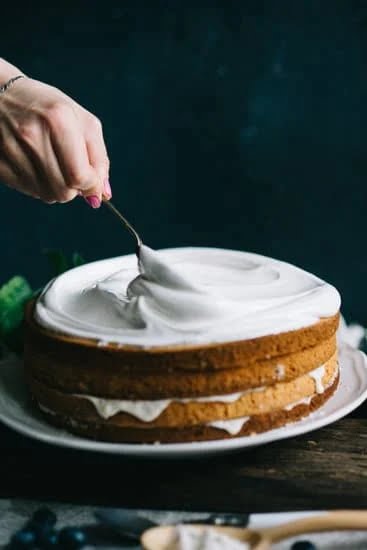Are you looking to elevate your cake decorating skills? If so, learning how to make a firm cake for decorating is essential. A firm cake not only provides a solid foundation for decorative elements but also ensures that the finished product looks professional and polished.
When it comes to cake decorating, the texture and stability of the cake are crucial factors. Without a firm base, decorative elements such as frosting, fondant, and decorations can easily become misshapen or slide off. In this article, we will dive into the steps and techniques for creating a sturdy and reliable cake that is perfect for decorating.
By following the tips and guidelines provided in this article, you will gain valuable insight into selecting the right recipe, proper baking techniques, maintaining the firmness of the cake during cooling and handling, as well as best practices for stacking, assembling, frosting, and decorating your cake. Whether you are a beginner or an experienced baker looking to improve your skills, mastering the art of making a firm cake for decorating will take your creations to the next level.
Let’s get started on creating cakes that are as beautiful as they are delicious.
Choosing the Right Cake Recipe
When it comes to creating a firm cake that is perfect for decorating, the choice of cake recipe plays a crucial role. The right type of cake recipe can make all the difference in achieving a sturdy and level cake that is ideal for adding decorative elements. Here are some tips for selecting a cake recipe that will result in a firm and sturdy cake.
Consider the Type of Cake
Different types of cakes have different textures and structures. If you are looking to make a firm cake for decorating, consider choosing recipes for dense cakes such as pound cakes, sponge cakes, or butter cakes. These types of cakes have a tighter crumb and are less likely to crumble or fall apart when stacked or layered.
Pay Attention to Fat Content
The fat content in a cake recipe can also impact its firmness. Look for recipes that include ingredients such as butter, oil, or sour cream, as these can contribute to a denser and more solid texture. Avoid recipes with high levels of liquid fat such as vegetable oil, as they can result in a softer and more delicate cake.
Test Different Recipes
If you’re unsure about which cake recipe will result in the firmness you desire, don’t be afraid to experiment with different recipes. Try baking small test batches of different types of cakes to see which one yields the best results for decorating. This trial and error process can help you identify the perfect recipe for creating a firm and sturdy cake.
By carefully considering the type of cake, paying attention to fat content, and experimenting with different recipes, you can ensure that you choose the right cake recipe for making a firm cake that is perfect for decorating. Understanding these tips will set you on the right path toward creating a beautiful and structurally sound canvas for your decorative designs.
Proper Baking Techniques
When it comes to creating a firm cake for decorating, the baking process is crucial. The right techniques can make all the difference in achieving a sturdy and level cake that provides a solid foundation for decorating. Here are some essential tips for proper baking techniques:
1. Use the right cake pan: Choosing the appropriate cake pan can greatly impact the firmness of your cake. Opt for high-quality, heavy-duty pans that distribute heat evenly and result in a consistently baked cake. Avoid using thin or flimsy pans that may cause uneven baking and affect the overall stability of the cake.
2. Properly prepare the pan: Before pouring your batter into the pan, make sure to properly prepare it to prevent sticking and ensure an even rise. Consider using parchment paper or a non-stick spray to coat the inside of the pan, and then lightly dust it with flour.
3. Monitor baking time and temperature: Following the recommended baking time and temperature specified in your chosen recipe is essential for achieving a firm cake. Underbaking can result in a soft and unstable texture, while overbaking can lead to dryness. Use an oven thermometer to ensure accuracy and check for doneness with a toothpick or cake tester inserted into the center of the cake.
By following these proper baking techniques, you can increase your chances of producing a firm cake that is perfect for decorating. Taking these important steps during the baking process will set you on the path to creating beautiful, stable cakes that provide an ideal canvas for your creative decorations.
Cooling and Handling
Once your cake is out of the oven, it’s crucial to take the right steps to ensure that it maintains its firmness. One of the most important things to remember during this stage is to let the cake cool completely before handling it. This will allow the structure of the cake to set and become firm, making it easier to work with when it comes time for decorating.
Another important step in maintaining the firmness of your cake is to carefully remove it from the baking pan once it has cooled. You can do this by running a knife around the edges of the pan to loosen the cake, then gently tapping the bottom of the pan to release it. Be sure to handle the cake with care during this process to avoid any unnecessary damage.
After removing the cake from the pan, place it on a wire rack to continue cooling. Allowing air to circulate around the entire cake will help prevent moisture from building up and causing it to become soggy or lose its firmness. Once completely cooled, you can proceed with any further steps for decorating or assembling your cake.
| Important Step | Description |
|---|---|
| Cooling | Letting the cake cool completely before handling |
| Removing from pan | Gently removing the cake from the baking pan without damaging its structure |
| Cooling on wire rack | Allowing air circulation for continued cooling and firmness maintenance |
Stacking and Assembling
Choosing the right cake recipe is crucial for creating a firm cake that is suitable for decorating. Look for recipes that include ingredients such as butter, whole milk, or sour cream, as these ingredients add moisture and richness to the cake while also providing structure. Avoid recipes with too much liquid or oil, as this can result in a soft and unstable cake that may not hold up well to decorating.
Proper baking techniques are essential for ensuring that your cake turns out firm and level. Be sure to accurately measure your ingredients, particularly the flour, and follow the recipe instructions closely. Overmixing the batter can lead to a dense and heavy cake, so mix the ingredients just until they are combined.
Additionally, using the right size and type of baking pan can impact how your cake bakes. For example, using a darker pan can cause the edges of the cake to cook faster and become too firm before the center is fully baked.
After your cake is done baking, it’s important to allow it to cool properly in order to maintain its firmness. Let the cake cool in the pan on a wire rack for about 10-15 minutes before removing it from the pan.
Once removed, let it continue to cool completely on the rack before attempting to stack or decorate it. This cooling process allows the internal structure of the cake to set and avoids any potential collapse or damage when stacking layers.
| Cake Firmness Tips | Key Techniques |
|---|---|
| Choose recipes with butter or whole milk | Accurately measure ingredients |
| Avoid excessive oil or liquid | Mix batter just until combined |
| Select proper baking pans | Cool completely before stacking/decorating |
Best Practices for Frosting
Choosing the Right Frosting
When it comes to making a firm cake for decorating, the type of frosting you use is crucial. Buttercream and cream cheese frostings are popular choices because they hold their shape well and provide a stable base for decorating. Whipped cream or meringue-based frostings, on the other hand, can be too soft and delicate, making it challenging to create intricate designs.
Applying a Crumb Coat
Before applying the final layer of frosting, it’s essential to start with a crumb coat. A crumb coat is a thin layer of frosting that seals in any loose crumbs on the cake’s surface, providing a smooth foundation for the final layer. To apply a crumb coat, spread a thin layer of frosting over the entire cake, then chill it in the refrigerator for about 15 minutes before adding the final layer of frosting.
Using Proper Technique
When applying frosting to a cake, using the right technique can make all the difference in maintaining its firmness. Use an offset spatula to spread the frosting evenly across the cake’s surface, working from the center towards the edges.
Avoid pressing too hard on the cake while spreading the frosting as this can cause it to become soft or unstable. Additionally, be mindful of any air bubbles in the frosting and gently smooth them out with your spatula for a flawless finish.
By following these best practices for frosting, you can ensure that your beautifully decorated cake remains firm and stable throughout the decorating process. These techniques will help you achieve professional-looking results while maintaining the integrity of your delicious creation.
Decorate Like a Pro
Decorating a cake can be the most exciting part of the entire baking process, but it’s essential to do so without compromising the firmness of the cake. Here are some techniques for adding decorative elements to your firm cake without damaging its structure:
- Use a crumb coat: Before applying the final layer of frosting, it’s crucial to apply a thin layer of frosting, known as a crumb coat, all over the cake. This will help seal in any loose crumbs and create a smooth base for your decorative frosting.
- Invest in the right tools: Using sturdy cake decorating tools such as offset spatulas and bench scrapers will help you add decorative elements to your cake without causing it to shift or become unstable.
- Be mindful of weight: When adding heavier decorative elements such as fondant or sugar decorations, make sure that the underlying layers of frosting and cake can support the added weight. Consider using additional supports for particularly heavy decorations.
In addition to these techniques, it’s also important to consider the placement and timing of adding decorative elements to your firm cake. For example, if you’re using fresh fruit as a decoration, it’s best to add it just before serving to prevent it from releasing moisture and potentially softening the surrounding frosting.
By following these tips and techniques, you can ensure that your beautifully decorated cake remains firm and stable throughout the decorating process.
Ultimately understanding how to make a firm cake for decorating is key not only for achieving visually appealing results but also for ensuring that your masterpiece holds up until it’s time to be enjoyed by eager guests. With these helpful techniques in mind, you’ll be able to confidently adorn your cakes with impressive decorations while maintaining their structural integrity.
Troubleshooting
When trying to make a firm cake for decorating, there are some common issues that can arise during the baking and decorating process. One of the most common problems is a cake that is too moist or soft, making it difficult to work with when adding decorative elements. This can be caused by using a recipe with too much moisture, overmixing the batter, or underbaking the cake.
To address this issue, one solution is to choose a cake recipe that is specifically designed to result in a firmer texture. Look for recipes that call for ingredients like sour cream or yogurt, which can help provide structure and stability to the cake.
Additionally, pay attention to the mixing technique – do not overmix the batter, as this can lead to a softer texture. Lastly, ensure that the cake is baked for the full recommended time and test it with a toothpick before removing it from the oven.
Another common issue when making a firm cake for decorating is uneven baking, which can result in a lopsided or domed cake. This can be caused by an uneven oven temperature or improper placement of the cake pan in the oven. To solve this problem, invest in an oven thermometer to accurately gauge the temperature of your oven and make adjustments as needed. Additionally, rotate the cake pans halfway through the baking time to promote even baking.
By addressing these common issues and implementing these solutions, you can ensure that your cake turns out firm and sturdy, ready to be decorated with beautiful frosting and decorative elements.
Conclusion
In conclusion, making a firm cake for decorating is an essential skill for any aspiring baker or cake decorator. By understanding the importance of a sturdy cake base, choosing the right recipe, and implementing proper baking techniques, you can ensure that your cakes are firm and level.
After baking, it is crucial to handle the cake with care during the cooling and handling process to maintain its firmness. Additionally, following best practices for frosting and decorating will help you create beautiful cakes without compromising their structure.
Now that you have learned how to make a firm cake for decorating, it’s time to put your newfound knowledge into practice. Experiment with different recipes and baking techniques to find what works best for you. Remember to take your time when stacking and assembling the cake, ensuring that each layer is level and secure. When it comes to frosting and decorating, be gentle but confident in your movements, applying decorative elements with precision and care.
As you continue on your baking and decorating journey, remember that practice makes perfect. Don’t be discouraged by any initial challenges you may encounter – troubleshooting common issues will only make you a better baker in the long run. With dedication and patience, you’ll soon be creating beautifully decorated cakes with a firm and stable structure that will impress all who see them.
Frequently Asked Questions
How Do You Make a Cake Firmer?
Making a cake firmer can be achieved by adding less liquid or using ingredients that absorb moisture, such as almond flour or Greek yogurt. Overmixing the batter can also result in a firmer cake.
How Do You Make a Cake More Dense for Carving?
To make a cake more dense for carving, you can try using all-purpose flour instead of cake flour, reducing the amount of leavening agents like baking powder or soda, and increasing the amount of fats like butter or oil.
What Makes a Cake Harden?
Several factors can cause a cake to harden over time, including overbaking, exposure to air, and improper storage. Using too much flour or sugar in the recipe can also lead to a harder texture in the finished cake.

Welcome to our cake decorating blog! My name is Destiny Flores, and I am the proud owner of a cake decorating business named Cake Karma. Our mission is to provide delicious, beautiful cakes for all occasions. We specialize in creating custom cakes that are tailored specifically to each customer’s individual needs and tastes.





